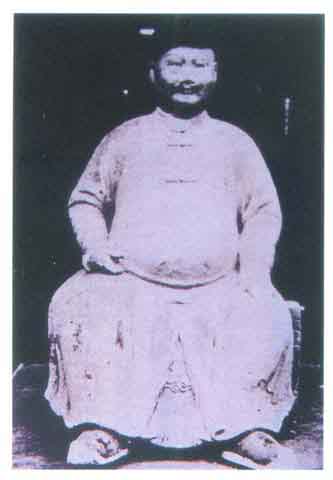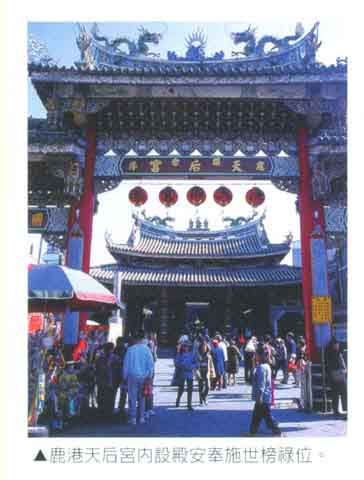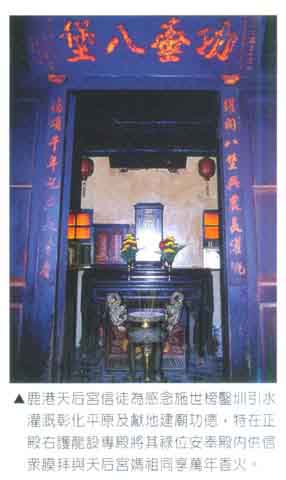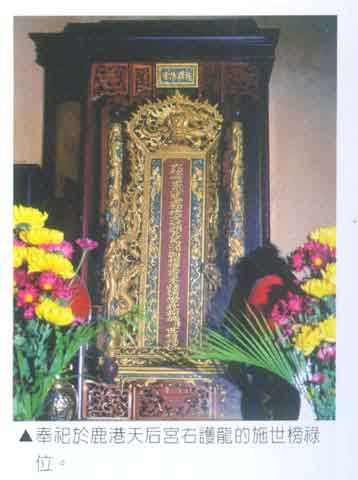
Your Site﹥﹥homepage﹥Hall of Fame﹥Chang-ling Shih
| Hall of Fame | Chang-ling Shih | Shih-cing Huang | Lin Siansheng |
Chang-ling Shih
Chang-ling Shih was the cultivator name of Shih-bang Shih.
Shih-bang Shih, original name Si-cheng, courtesy name Wen-biao, and style name Cang-ting. Born in 1671, died in 1743 (October 25, 1671-January 2, 1743), the person who began Taiwan’s important hydraulic construction work, Babao Canal.
1. Son following the father’s work
Shih-bang Shih’s father’s name was Chi-ping Shih, art name Lu-meng, taboo name Shih-tung, Chi-ping Shih was the genealogical name. He was the youngest son with two elder brothers, Chi-teng and Chi-jen.
Chi-ping Shih was originally from Jinjiang County, Quanzhou Prefecture, Fujian Province. After Fujian Naval Admiral Shih Lang attacked Taiwan in 1683, they moved to Tainan and worked in the deer hide and sugar business. They also exported goods to Japan, which made them rich. Then, they moved to Lugang and Banxian (present-day Changhua) in central Taiwan. They turned to the cultivation and planting business, working in the important position of “cultivation leader,” with the cultivation code “Changling,” which was then inherited by Shih-bang Shih.
At the time, Lu-meng Shih worked as Fengshan selection tribute (Note 1), and then he was promoted to vice commander of the soldiers and horses bureau. When inspecting the Changhua Plains, he discovered that while this area had undeveloped flat lands, they were not being utilized. Thus, he began planning hydraulic infrastructure and raising funds for construction.
Later, Shih-bang Shih took over his father’s work. In 1719, he gathered unemployed people in Changhua to cultivate the sediment plains of Tungluo River, at the same time constructing canals to convey water from Jhuoshuei River to irrigate farms.
* Note 1: Qing Dynasty recommendation system. According to the regulations, every 12 years, the academic ministers select those with outstanding literary and behavioral achievement to present to the capital, called selection tribute. The people who were selected were court-examined by the Ministry of Rites. Those who tested into the first and second levels were then placed into seventh-level small capital officials, county chiefs, or teaching positions.
2. Construction of the canal
(1) Tall mountains in central Taiwan, convenient for hydraulics.
When Shih-bang Shih came with his father to Taiwan, he saw that central Taiwan has many mountains, with large drops in water flow, and rich water resources. However, water was lacking in the dry seasons, as there were clear differences between dry and wet seasons, so that the farms could not be fully cultivated. Thus, in 1709 he began to construct the canal to resolve irrigation problems. The canal head was established at Bitsaitou (present-day Changhua County Ershui Township), and channels began to be dug to convey the water from Jhuoshuei River to irrigate fields. Thus, in present-day Linsiansheng Temple of Yuanchuan Village, there is still a stone plaque that marks “The Source,” which commemorates the establishment of the source of Babao Canal here.
(2) Early problems, encountering Lin Siansheng.
At the beginning of the canal construction period, he encountered problems in construction; the main problem was a bottleneck in the water conveyance method. Thus, Shih-bang Shih used a thousand pieces of gold as an award for the solution. Then, an unknown elderly man appeared to teach him about the digging method – use rattan-woven conical dam cages that were wide at the head and narrow at the tail in the canal. The canal then successfully conveyed water. This water conveyance method was called “dam cage.” When water was abundant, dam cages can prevent the water from directly crashing into the canal route and damaging it; in the dry season it can gather water for conveyance into the canal. Its shape is like an upside-down bamboo shoot, thus it is also called “round bamboos shoot” or “upside-down bamboo shoot.”
Later, Shih-bang Shih and local residents wanted to thank the old man, but he refused to accept his reward, would not tell them his name, and finally disappeared, leaving only his shoes between two trees. Thus, they called him “Lin Siansheng”. In remembrance of his help, people constructed a temple near the Ershui intake, calling it the “Linsiansheng Temple”.
(3) Shicu Canal widely irrigated the hinterland.
Shih-bang Shih took ten years to finally complete the canal in 1719. It flows past 103 villages, covering more than half of Changhua County. The irrigated hinterland was the largest hydraulics construction in Taiwan under Qing rule. Since the canal used water from Jhuoshuei River, at first it was called “Jhuoshuei Canal.” Later, because of Shih-bang Shih’s monetary and practical investment, the villages called the canal “Shicu Canal.” Then, after the “bao” system was implemented in Changhua, there were thirteen and a half bao of farmland in the area. The amount of water in the canal was sufficient to irrigate eight bao, thus it is also known as “Babao Canal”. Each year, the Shih family collected tens of thousands of dan of grain from the tenant farmers of Babao Canal each year, so the children and grandchildren was always wealthy.
(4) Under Japanese rule, the canal was forcibly nationalized.
After Japan took over Taiwan, the ownership of the canal was forcibly nationalized in 1897, combined for jurisdiction under the public canal association in Taichung Prefecture. At the same time, Gu Xianrong of Lugang was promoted as the canal chief responsible for managing canal affairs.
(5) Construct Linsiansheng Temple, with great popularity for worship.
There was no temple for Shih-bang Shih in Taiwan, but there are two temples in Taiwan that housed Chang-ling Shih. One of them was in the “Linsiansheng Temple” at the source of Bitsaitou Babao Canal in Ershui Township of Changhua County. The tenant farmers in Changhua wanted to commemorate the merit and virtue of Lin Siansheng, then they established the “Linsiansheng Temple”, which mainly worshipped Lin Siansheng, along with other rank plaques of Shih-bang Shih and Shih-cing Huang who were also responsible for the canal. In another place, it is in the right chamber room of Lukang Matzu Temple. The righteousness of Shih-bang Shih helped tens of thousands of people, such as constructing Jingsheng Building, repaired Fengshan County Academy, donated tuition for Donghai Academy, constructed Enshe Bridge, and repaired Jinjiangwen Temple.
 |
 |
||
| Painting of Shih-bang Shih. From: Legendary Historical Materials of Babao Canal in Changhua edited by HongYingsheng. | Lukang Tianhou Temple, with a hall for the rank plaque of Shih-bang Shih. | ||
 |
 |
||
| Lukang Tianhou Temple houses the rank plaque of Shih-bang Shih. The plaque says “Great Merit over Babao.” | Shih-bang Shih’s rank plaque housed in the right chamber in Lukang Tianhou Temple. |